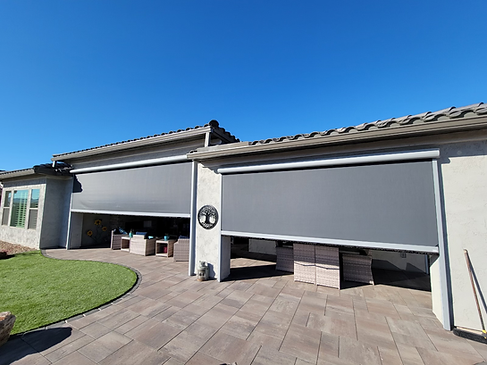Tucson Solar Screens
- Sun Shield Products
- Jun 25, 2019
- 3 min read
Here are some quick Q&A for Solar Screens.
Q: If I am replacing my insect screens with new screening products, what spline size should I use?
A: If you do not have a sample of your old spline to match the size, then the product that is being installed and the screen frame’s spline groove determine spline size. Measure across the spline channel or groove of the screen frame and use one size smaller spline for fabrication.
Q: What is Water Shed Technology™ and how does it work?
A: Water Shed Technology is an advanced water repellent (hydrophobic) coating that allows the screen to easily shed water and other substances. The coating virtually eliminates "window paning," a process by which water fills the open squares during a rain storm.
Q: Which products are best for a coastal/high humidity climate?
A: All fiberglass screens, sun control screens, TuffScreen® and PetScreen®.
Q: Which products provide the best insect protection?
A: Fiberglass 20×20 “No-See-Ums screen” provides the maximum protection. BetterVue® provides 10% more insect protection vs. standard fiberglass or aluminum screen.
Q: Which products are the longest lasting?
A: All Phifer products are made to provide years of enjoyment and protection.
Q: Which products provide extra strength?
A: In traditional screen applications, 18×14 .013 fiberglass is 50% stronger than standard fiberglass insect screen. The most durable screen is PetScreen and TuffScreen.
Q: Which products allow the best airflow?
A: UltraVue® provides the maximum ventilation. Airflow is improved 25% vs. standard fiberglass or aluminum screen. Both BetterVue and SeeVue® yield a 20% improvement in airflow vs. standard fiberglass or aluminum screen.
Q: Which products have the best outward visibility/view?
A: UltraVue and SeeVue provide the maximum clarity/best viewing experience. BetterVue offers a better view than standard fiberglass or aluminum screen.
Q: Which products block solar heat and glare?
A: SunTex® 80 and SunTex 90, Solar Insect Screen, and SunScreen
Q: Which products will provide daytime privacy?
A: SunTex 80 and SunTex 90, Solar Insect Screen, and SunScreen® are excellent choices for daytime privacy screening.
Q: Will Bronze screen turn green?
A: No, this product weathers to a beautiful dark bronze finish that enhances outward visibility.
Q: How do you clean insect screening?
A: Rinse metal products with water only. Clean vinyl products with a mild soapy solution, avoiding hard scrubbing.
Q: What is Less Visible Screen?
A: It’s the latest innovation in insect screen. The product’s design uses finer yarns in a tighter mesh. The design creates more holes per square inch improving ventilation and optical clarity. The result is better performing insect screen. Aperture openings are smaller improving insect protection.
Q: Why use Less Visible Screen?
A: If you like clear unobstructed views then you need one of Phifer’s iVis solutions. Traditional screens are easily seen from inside or outside the home. BetterVue and UltraVue are almost invisible. They improve viewing clarity, brighten windows using Low-e glass, and improve airflow and ventilation. Exterior screens are harder to detect from the curb. Phifer’s BetterVue and UltraVue are GREENGUARD® certified and have Microban® antimicrobial product protection to stay cleaner longer.
Q: What is the difference between iVis-Improved visibility screen and eVis-Excellent visibility screen?
A: The primary difference is openness resulting from yarn size. Smaller yarns typically provide better clarity. Improved visibility insect screen was developed as an affordable solution so all consumers could enjoy less visible screen. Excellent visibility insect screen offers homeowners the highest clarity. It is more delicate and typically used in low traffic areas like windows. The cost is considerable higher but its worth the view.
Q: Are Less Visible Screens as durable as standard screen?
A: To improve clarity we must use finer yarns. Basically you sacrifice some strength for improved clarity. Durability is a result of product design. Less visible screens typically weave more yarns per square inch to offset the loss of strength from finer yarns. Compared to the industry’s standard screen, BetterVue is similar in durability. UltraVue is less durable but offers a premium view.
Q: How do I calculate the mesh size of window, door or pool/patio screen?
A: To determine the mesh size of screening, first create a template by cutting a 1x1 square inch piece of paper, then tape the piece of paper to your window screen, aligning both horizontal and vertical borders with the lines in the mesh. Next, count the number of square openings you see next to the paper first horizontally, then vertically. If you counted 18 horizontally, and 16 vertically, your mesh size is 18x16.
Q: Fiberglass vs. Aluminum Insect Screening: What Is The Difference?
A: Both aluminum and fiberglass are very common options for insect screening, but provide different benefits. Which option is right for you depends on your prioritization of price, durability, and visibility. If you're not sure which option is right for your application, give our personalized screening quiz a try by clicking here or on the insect icon at the top of the page.









Comments